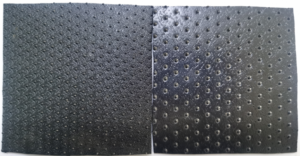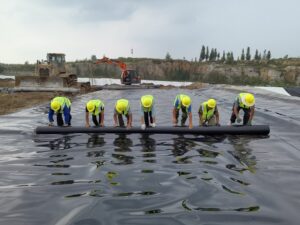The difference between hdpe geomembrane and pvc geomembrane
High-density polyethylene (HDPE) geomembrane and polyvinyl chloride (PVC) geomembrane are both types of synthetic liners used in various applications, particularly in civil engineering and environmental projects. While they share the common purpose of providing containment and barrier functions, there are notable differences between HDPE and PVC geomembranes. Here are some key distinctions:
Material Composition:
HDPE Geomembrane: It is made from high-density polyethylene, a thermoplastic polymer known for its high strength, flexibility, and chemical resistance.
PVC Geomembrane: It is made from polyvinyl chloride, another thermoplastic polymer that is known for its versatility, durability, and resistance to chemicals.
Flexibility:
HDPE Geomembrane: HDPE is generally more flexible and has a higher elongation at break compared to PVC. This can be advantageous in applications where flexibility and deformation are important.
PVC Geomembrane: PVC is typically less flexible than HDPE, but it still offers a good balance between flexibility and stiffness.
Chemical Resistance:
HDPE Geomembrane: HDPE is resistant to a wide range of chemicals, making it suitable for applications where exposure to aggressive substances is a concern.
PVC Geomembrane: PVC also has good chemical resistance, but its performance can vary depending on the specific chemicals involved. PVC may not be as suitable for applications involving certain solvents or hydrocarbons.
Temperature Resistance:
HDPE Geomembrane: HDPE has good resistance to temperature variations, including both low and high temperatures.
PVC Geomembrane: PVC also has good temperature resistance but may be more prone to becoming brittle at very low temperatures.
Seamability:
HDPE Geomembrane: HDPE geomembranes are often seamed using techniques like heat-welding, making them well-suited for large-scale installations.
PVC Geomembrane: PVC geomembranes can be seamed using heat-welding or chemical bonding methods.
Installation and Repair:
HDPE Geomembrane: HDPE is often considered easier to install due to its flexibility and the availability of various welding techniques for seaming. Repairs can be done through welding or patching.
PVC Geomembrane: PVC geomembranes are also installed through welding or adhesive bonding. Repairs typically involve patching or sealing methods.
Cost:
HDPE Geomembrane: HDPE geomembranes are generally more cost-effective than PVC geomembranes.
Ultimately, the choice between HDPE and PVC geomembranes depends on the specific requirements of the project, including environmental conditions, chemical exposure, flexibility needs, and budget considerations. Both materials have their advantages and are widely used in different applications within the geosynthetics industry.
Which is better, hdpe geomembrane or pvc geomembrane?
The choice between HDPE (High-Density Polyethylene) geomembrane and PVC (Polyvinyl Chloride) geomembrane depends on the specific requirements of the project and the environmental conditions. Each material has its own advantages and disadvantages, and the “better” option depends on factors such as the application, site conditions, and budget constraints. Here are some considerations to help you decide:
Chemical Resistance:
HDPE Geomembrane: HDPE is known for its excellent chemical resistance, making it suitable for applications where exposure to a wide range of chemicals is a concern.
PVC Geomembrane: PVC also has good chemical resistance, but its performance can vary depending on the specific chemicals involved. HDPE is generally preferred in applications with more aggressive chemical exposure.
Flexibility:
HDPE Geomembrane: HDPE is more flexible and has a higher elongation at break compared to PVC. This flexibility can be advantageous in applications where deformation and flexibility are important.
PVC Geomembrane: PVC is less flexible than HDPE but still offers a good balance between flexibility and stiffness.
Temperature Resistance:
HDPE Geomembrane: HDPE has good resistance to temperature variations, including low and high temperatures.
PVC Geomembrane: PVC also has good temperature resistance but may be more prone to becoming brittle at very low temperatures.
Seamability:
HDPE Geomembrane: HDPE geomembranes are often seamed using techniques like heat-welding, making them well-suited for large-scale installations.
PVC Geomembrane: PVC geomembranes can be seamed using heat-welding or chemical bonding methods.
Installation and Repair:
HDPE Geomembrane: HDPE is often considered easier to install due to its flexibility and the availability of various welding techniques for seaming. Repairs can be done through welding or patching.
PVC Geomembrane: PVC geomembranes are also installed through welding or adhesive bonding methods. Repairs typically involve patching or sealing.
Cost:
HDPE Geomembrane: HDPE geomembranes are generally more cost-effective than PVC geomembranes.
In summary, there is no one-size-fits-all answer, and the choice between HDPE and PVC geomembranes should be based on the specific needs and conditions of the project. If chemical resistance and flexibility are critical, HDPE might be preferred. However, if cost considerations or specific site conditions favor PVC, it could be a suitable choice. Consulting with geotechnical engineers or specialists in geosynthetic materials can help determine the most appropriate solution for your particular application.
Author

Founded in 2002, Tinhy's team focuses on the manufacturing, marketing, installation, application and research and development of geosynthetic materials.
View all posts






